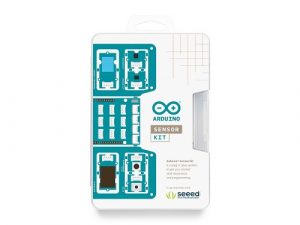It contains a Base Shield and ten Grove modules that can be connected either through the digital, analog or I2C connectors on the shield (there are accompanying lessons for the use of each module).
Is the UNO included? The Arduino Sensor Kit is available either as a standalone kit for US$/€23.00 or as a bundle with an Arduino UNO Rev3 board for US$/€38.70.
The Arduino team writes:
“Ideal for anyone who currently uses an Arduino UNO board and wants to create and launch their own D.I.Y projects, the kit integrates the 10 most popular Grove sensors and actuators all on one board. Users can plug, sketch and play without any additional wiring required or learning how to solder. It is, however, also great for more advanced users who wish to reduce time on circuitry and build quickly.”
Hardware software
In terms of its hardware, a Base Shield – designed to fit on top of an Arduino UNO board – comes equipped with 16 grove connectors, which, when placed on top of the UNO, provides functionality to various pins. It includes connections as follows: 7x digital, 4x analog, 4x I2C and 1x UART.
 The 10 Grove modules included, which can be connected to the base shield either through the digital, analog or I2C connectors on the shield – are:
The 10 Grove modules included, which can be connected to the base shield either through the digital, analog or I2C connectors on the shield – are:
- The LED – simple LED that can be turned ON or OFF, or dimmed.
- The button – pushbutton that can either be in a HIGH or LOW state.
- The potentiometer – a variable resistor that increases or decreases resistance when turning its knob.
- The buzzer – a piezo speaker that is used to produced binary sounds.
- The light sensor – a photoresistor that reads light intensity.
- The sound sensor – a tiny microphone that measures sound vibrations.
- The air pressure sensor – reads air pressure, using I2C protocol.
- The temperature sensor – reads temperature and humidity at the same time.
- The accelerometer – a sensor used for orientation, used for detecting movement.
- The OLED screen – a screen that values or messages can be printed to.
There are also six Grove cables for connecting the modules to the Base Shield without any soldering.
For software, the Arduino Sensor Kit Library is described as a “wrapper” that contains links to other libraries related to certain modules such as the accelerometer, air pressure sensor, temperature sensor and the OLED display.
“We are constantly seeking to simplify complex technologies,” said Alessandro Ranelluci, Head of Makers & Community at Arduino. “By combining 10 of the most popular add-ons and sensors into one plug and play kit for the board that began the journey into electronics and coding for millions of people – the Arduino UNO – it’s just got even easier for users to start making projects that sense and interact with the world around them.”
